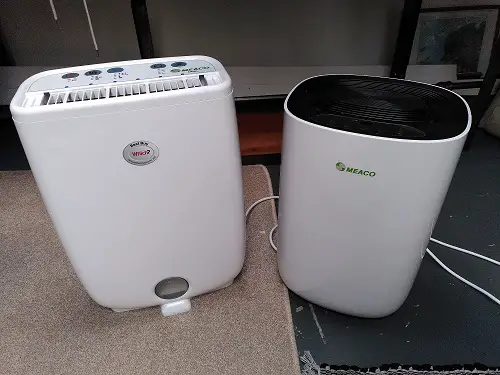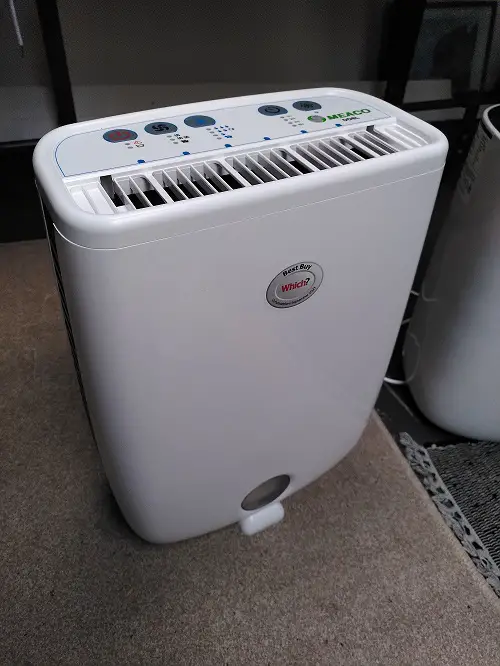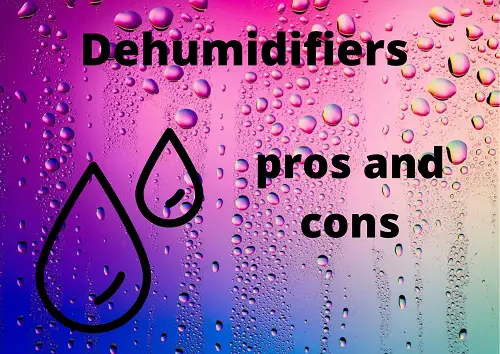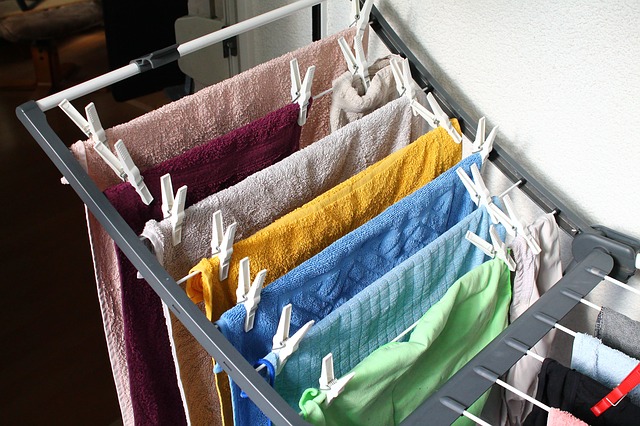A dehumidifier helps to lower the relative humidity of your indoor air. This helps improve air quality, and has many benefits. However, there are several cons to using a dehumidifier as well. In this article, I go over all the pros and cons of using a dehumidifier.

Pros of dehumidifiers
- it enables you to regulate the amount of air moisture
- increases thermal comfort
- makes the air healthier to breathe
- lowers the chances of respiratory issues
- helps with allergens
- reduces dust mites
- lowers the risk of mold growth
- can reduce asthma, bronchitis, and COPD symptoms
- prevents musty odor
- prevents condensation
- lowers chances of moisture damage to furniture
- helps speed up the drying of laundry
- protects papers, books, and paintings from moisture damage
- reduces rusting
Cons of dehumidifiers
- they can make quite some noise
- might not work in low temperatures
- needs regular maintenance
- can be quite large and heavy
- uses electricity constantly
- increases energy bill
- purchase costs are around $200
- windows and doors need to be closed

The pros of using a dehumidifier
A dehumidifier lowers air moisture (when necessary)
A dehumidifier removes vaporized water from the air. In this way, it lowers the humidity and prevents many problems associated with humid air. However, you do not want to create levels of air moisture that are too low, since that comes with its own range of problems. Luckily, many dehumidifiers have a function that allows you to set the desired humidity. In this way, you have control over the amount of moisture in your air.
A dehumidifier is useful only when you have high levels of humidity and want to lower it.
Having control over the moisture levels in your air allows you to always create the most comfortable air and therefore living space.
If you want to know how a dehumidifier works exactly. I recommend reading my article about how compressor and desiccant dehumidifiers work:
A dehumidifier creates thermal comfort
The relative humidity of the air is a large factor in your thermal comfort. Thermal comfort does not only come from a comfortable temperature but is also determined by the level of humidity. Lowering the relative humidity (RH) of humid air to the recommended 30 to 60 % RH optimizes your thermal comfort.
Humidity influences your thermal comfort in the following way:
- high moisture levels increase the feeling of being cold when the temperature is low, and;
- high moisture levels increase the feeling of heat when the temperature is high
So, high moisture levels both increase the feeling of being cold as well as that of being warm. How does that work?

Feeling too hot: high temperatures and high humidity
When the temperature is high, your body starts to sweat in order to lose its heat and cool down. However, sweating is done by evaporating moisture from your skin. This evaporation is more complicated when the amount of moisture in the air is high.
Because you cannot easily lose your body heat by evaporating sweat, your feeling of being too hot will increase.
Feeling cold: low temperature with high humidity
When the temperature is low and you have high humidity, you will not sweat to lose heat. However, the moisture in the air makes the air wetter, and wet air touching your skin makes you feel similar to losing heat through sweating.
Additionally, your body heat creates a warm pocket of air between your skin and your clothes that keeps you warm. However, when the air has a high moisture content, your clothes contain more moisture than in dry air. This then works similarly to sweating. Your body heat is evaporating the water in your clothes, making you lose the heat.
For a more in-depth explanation of how humidity affects our perception of temperature, I recommend reading my article:
Dehumidifiers create healthy air
Lowering the humidity does not directly make the air healthier to breathe. However, air moisture affects existing breathing issues, worsening them when humidity is high (or when it’s too low). Additionally, many allergens such as mites and mold/mildew thrive at higher humidity levels. Molds can start to grow at relative humidity (RH) of 60% and mites prefer 70 to 80 % RH.
Less respiratory issues
High humidity can lead to an increase in respiratory (breathing and lung) issues. It can lead to more frequent coughing and a runny nose. (source)
It can increase the severeness and frequency of existing respiratory problems such as:
- asthma
- bronchitis, and
- COPD
Air that is excessively humid feels harder to breathe because it triggers nerves in your lungs that tighten your airways, making them more narrow. Therefore, people with respiratory problems will likely experience more issues when the air is too humid.
Additionally, high humidity is when allergens like mites and molds thrive. This will also increase the chances of asthma and bronchitis triggers.
Dehumidifiers help reduce allergens
Many allergens are in some way related to your air humidity. For example, high humidity increases the presence of allergens like:
- mold and mildew
- (dust) mites
Normally, relative humidity between 30 and 60 % is recommended. When you suffer from allergies, however, narrowing the humidity levels to 40 – 50 % is optimal to ease symptoms. (source)
Mold and mildew thrive at high humidity levels
When mold and mildew are allowed to grow, they start to produce more and more spores that are released into the air. This increases the number of spores in the air above natural background levels and can trigger allergic reactions.
Dust mites thrive at high humidity levels
Dust mites live in carpets, bedsheets, curtains, etc. They live off of dust and prefer high humidity levels of 70%. The excrements and dead bodies of mites are common allergens.
You can reduce the number of dust mites present in your home by lowering the air humidity with a dehumidifier.

Dehumidifiers reduce mold and mildew
Molds and mildew thrive at elevated humidity levels (60% and higher). There are thousands of mold spores in the air at all times and they can grow on any surface as long as there is sufficient moisture present. Therefore, they are most common in the bathroom and basement.
However, when the humidity of your air increases, they will start to grow anywhere in the house. As discussed earlier, mold and mildew can release allergens into the air, causing respiratory problems. However, mold and mildew will also slowly eat away at the surface on which they are growing. This means that wood and paper will be destroyed over time. However, it can also weaken the structural integrity of our home, often without us knowing.
Reducing your air humidity levels is the best way to prevent their growth.
The following picture was taken in my own bedroom where I found mold due to condensation on the wall. As you can see, dark spots are forming where water droplets are present. If left unchecked, these spots will grow in numbers rapidly over the course of a few days.

Dehumidifiers prevent condensation
Air moisture condensates on surfaces when the air cannot contain its moisture content anymore. This happens when the air has high moisture content and cools down by touching a cold surface. Since the air temperature drops, it cannot contain as much moisture, causing it to condensate. Lowering the humidity lowers the moisture content of the air and therefore the occurrence of condensation.
The air can contain a certain amount of moisture depending on the air temperature. High-temperature air can contain more moisture than low-temperature air. Therefore, when the temperature drops, the air cannot hold as much moisture. So when high-moisture air comes into contact with a cold surface such as a window, the moisture cannot stay evaporated and condensates on the window’s surface.
By making the water content of the air lower than what it can hold (with a dehumidifier), cooling down the air does not lead to condensation.
Dehumidifiers reduce rusting
The combination of moisture and oxygen causes metals to oxidate and rust. Since the air always contains some moisture, metal will start to rust over time. However, high humidity increases the moisture exposure of metals and therefore speeds up the rusting process.
Iron and many other metals start to rust over time. However, rust is caused by a reaction of iron with water and oxygen. When iron has been wet, oxygen starts to ‘eat’ at the iron, causing it to rust.
High humidity levels create a moist environment and increase condensation, causing metals to come into contact with moisture more often. This speeds up the rusting process. Therefore, lowering your humidity helps slow down rust.
Optimal humidity protects paper, books, and paintings
High humidity levels can lead to severe damage to books, papers, and paintings. Due to the high levels of moisture in the air, some of the moisture will either condensate on the books or simply be absorbed by the paper.
This leads to water damage that can cause pages to curl and discolor. Also, paper starts to swell when it gets wet. When the air and the paper dry again, it starts to contract again. This can happen at different rates since for example the cover and the binding are thicker than the pages. This can lead to warped pages.
Optimal humidity minimizes furniture damage
Lowering the amount of moisture in the air with a dehumidifier decreases the chance of moisture damage to furniture. By lowering humidity, your furniture and upholstery are less exposed to moisture. Therefore, they suffer less water-related damage such as expansion and contraction leading to warping.
Similar to papers and books, wooden furniture as well as upholstery can get water damage due to high humidity levels. Also, wood can start rotting when exposed to moisture for a long time.
Dehumidifiers can help dry laundry
When laundry is drying, it gives off its moisture to the surrounding air. However, when the humidity of the air is high, it already contains a lot of moisture. Therefore, this process is more difficult or can not even happen at all. Drying the air with a dehumidifier makes sure your laundry is able to lose its water content to the surrounding air.
I have tried to dry my laundry indoors during autumn and winter when it is cold and humidity levels are high. It simply does not work. Sometimes, when my clothes have dried relatively well, they just start to get wetter when humidity levels rise again.
Because the air contains so much moisture at high humidity levels, your laundry cannot lose its moisture in the air. Therefore, it simply doesn’t dry.
Since we use a dehumidifier in the room where we dry our laundry, we have no problem drying our laundry.
Dehumidifiers prevent musty odor
High humidity can lead to a musty odor. Therefore, using a dehumidifier helps prevent these odors. The main causes of a musty odor are the presence of high amounts of mold spores and suspended odor-causing particles. Mold spores are more plentiful in humid conditions, and odor-causing particles linger in stagnant humid air.
Due to high levels of humidity, molds and mildew can grow more easily and release more spores. This leads to an increase of spores above normal background levels. High amounts of airborne spores contribute to a musty smell.
Additionally, humid air is relatively stagnant compared to dry air. This leads to less airflow and poorer ventilation. Because of this, any particles that smell bad tend to linger in the air much longer.
The cons of dehumidifiers
The exhaust airflow can be bothersome
When you have a common compressor-type dehumidifier, the air coming out of the device can feel quite cold. This is especially true when you run the dehumidifier at temperatures around 60 degrees F (15 C). At these low temperatures, the device needs to occasionally run its defrosting mode to not freeze over.
If you have a desiccant dehumidifier, the air coming out of the device is about 50 degrees F (10 C) higher than the air in the room. This can be quite an annoyance when you are using the device in an already hot room.
A dehumidifier can make quite some noise
A dehumidifier can make noise of up to 65 decibels. However, the amount of noise entirely depends on the model you are using. Desiccant dehumidifiers are relatively quiet, often around 40 dB, while compressor dehumidifiers often produce about 50 dB.
Your dehumidifier might not work in low temperatures
Depending on the model you are using, a dehumidifier might work less well or not at all in low temperatures. As you can see in the table above, compressor dehumidifiers will not work as well or at all in temperatures below 15°C (60°F).
A compressor dehumidifier relies on creating a cold surface for water vapor to condense on. However, its efficiency starts to go down with dropping temperatures. Eventually, the mechanism can freeze and stop working.
A desiccant dehumidifier relies on a water-absorbing desiccant and will work at low temperatures, even below 0°C (32°F).
For an in-depth explanation of how dehumidifiers work, I recommend reading my article:
A dehumidifier needs regular maintenance
A dehumidifier requires regular maintenance in order to keep running. A dehumidifier with a tank needs to be emptied often in order to continue removing water vapor from the air. The exception is dehumidifiers with a hose and pump. Other maintenance includes cleaning and replacing filters, dusting, and checking the components for wear,
Apart from actual maintenance, you will regularly need to empty the water tank of your dehumidifier. The dehumidifier removes water vapor from the air and fills a tank that needs to be emptied for it to continue its job. The exception is if you have a dehumidifier that uses a pump and a hose to dispose of its water. In that case, you will need to station the device close to a sink so the hose can drain the water in the sink continuously.
A dehumidifier can be quite large and heavy
There is a huge difference in size and weight between the different available dehumidifiers. The following table shows an indication of the size and weight compared to the coverage area and how much moisture can be removed. You can check out the devices, and their price and features on amazon.com or sylvane.com by clicking on their link.
| Dehumidifier | Weight | Size | Water removal/day | Area coverage |
|---|---|---|---|---|
| REEMKIZZ 2300 | 1.68 lbs. (0.76 kg) | 5.3 x 5.3 x 8.7 inches (13 x 13 x 22 cm) | 16 oz (0.5 liters) | 218 sq. ft. |
| AIRPLUS 30 | 23 lbs. (10.4 kg) | 19.6 x 6.7 x 11.3 inches (50 x 17 x 28.7 cm) | 30 pints (14 liters) | 1500 sq. ft. |
| Danby 40 | 43.43 lbs. (20 kg) | 24 x 16 x 12 inches (61 x 41 x 30.5 cm) | 40 pints (20 liters) | 3000 sq. ft. |

A dehumidifier constantly uses electricity
For a dehumidifier to work optimally, it needs to run all day. Therefore, it will constantly use electricity. Dehumidifiers do not use all that much wattage. Depending on the device they can use between 20 and 250 watts. However, by running constantly, they will noticeably add to your energy bill at the end of the month.
The expected costs of running a dehumidifier will be something like the following:
- runs 24/7
- runs 30 days per month
- uses 200 watts per hour (0.2 kWh)
- electricity price of 14.2 cents per kWh (source: US Energy Information Administration)
This makes for a total of 144 kWh (0.2x24x30 = 144).
With a price of 14.2 cents/kWh, this leads to a monthly cost of $20.4
Running a dehumidifier constantly will increase your energy bill by approximately $20 per month

Purchase costs of dehumidifiers can be high
The purchase costs depend on the specific dehumidifier you are purchasing. The following table shows the costs of the dehumidifiers I used in the table for size and water removal comparison:
| Dehumidifier | Price | Area coverage | Water removal/day |
|---|---|---|---|
| REEMKIZZ 2300 | $35 | 218 sq. ft. | 16 oz (0.5 liters) |
| AIRPLUS 30 | $145 | 1500 sq. ft. | 30 pints (14 liters) |
| MeacoDry ABC 12L | $170 | 1250 sq. ft. | 25 pints (12 liters) |
| Danby 40 | $250 | 3000 sq. ft. | 40 pints (20 liters) |
Windows and doors need to be closed
Another slight disadvantage of running a dehumidifier is that you will need to reduce ventilation for optimal performance. Because ventilation brings in fresh outdoor air, it will also introduce more water vapor. In this way, some of the dry air your dehumidifier has produced is exchanged for humid outdoor air.
If you want to lower your indoor humidity as quickly as possible, you should prevent ventilation from bringing in air. this means shutting windows, doors, and other means of ventilation.
However, ventilation is the most important factor in creating healthy air to breathe. Therefore, although ventilation reduces the effectiveness of your dehumidifier, ventilation is highly recommended for healthy indoor air.
If you are interested in what determines if your air is healthy to breathe and how to create the most healthy indoor air, I recommend reading my article: The complete indoor air quality guide for your home.



